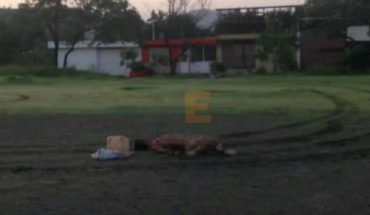“It was total chaos, “somewhat chaotic,” “a lot of uncertainty,” “parents report that the contents didn’t like children,” are the first sentences that elementary and secondary teachers say when asked how they lived on the first day of television school in this new school year.
Most tried to have everything organized and under control. Since last week they believed that parents, at least those who had managed to contact, had the information needed to find the classes and channels, so they prepared welcome messages that they mailed to their students by mail or WhatsApp and set out to start the cycle, but then that came, chaos.
Professor Jenny, who asks that she be identified only as well, fell into account early on, following her children’s classes, that her sixth graders should not see the contents assigned to that grade, scheduled to move to 1 in the afternoon, but the fifth.
As these three weeks are reviewed, the teacher, who works in an elementary school in Iztapalapa in Mexico City, explains that if her students followed sixth-grade programming, it would not actually be a review of the previous course.
Read: Indigenous communities face back-to-school without access to television or the internet
“I set up a meeting for 10am and by that time we had already missed the contents of fifth, so I told the parents that they could watch the replay, although it is already very night for the children because it is 9:30 pm until midnight. But then a mom sent us the application to download on the cell Phone Learn in Home 1 and they are already going to look there for the fifth”.
Alejandra Ikeda, a primary schoolmate teacher in León, Guanajuato, says that in her case today’s problem was that the schedules issued by the Federal Ministry of Public Education for that degree applied only for CDMX.
“Parents and students thought they were getting classes on television from 9:30 a.m. to 12 p.m., but that was just for the center. In Guanajuato the classes for room were broadcast from 4:30 to 7:00 in the afternoon and there was out of control. They started texting me in the morning on the what’s and I already sent them the right schedule and channel.”
Teacher Ikeda says that although she sent an explanation last week to parents on how to set up television so that they could watch the channels where the classes would be broadcast, she also received several messages from families early on asking how to do so.
For the first high school teacher, in Coatzacoalcos, Veracruz, Ricardo Zamudio, the most complex thing about this distance cycle is that he does not know his students, unlike the last course when the face-to-face classes were suspended almost in the middle of the school year and already knew each other well.
“We’re upside down. I don’t know the students, they don’t know each other, and they’re changing not only grades but levels. They’re going to be in a lot of interaction. As soon as we get back to normal this must be forgotten because it’s the opposite of what a school should be, it’s very impersonal.”
Of the 15 students he has in science class, for example, he says very few students have sent him evidence that they watched the classes on television.
Read: The Privilege of Returning to School: SEP Leaves Out Students With Disabilities
“They have to send me a picture of what they’re doing the activity they’re being asked to do there on TV, and only three have sent it to me.”
Claudia Iliana Limón, third high school teacher, in the field of science, in Zapopán, Jalisco, says that in that state they do not have the instruction to rely on the Learn at Home on television.
“Here we were asked to rely on interdisciplinary projects and use the Google or Microsoft platform for video calls, consultancies, but not all students have an internet network or are not so used to moving on platforms, there is a digital divide. I had three virtual sessions today with the groups and two, the morning sessions of 8:40 and 9:30, connected only half of each group; at 2:00 p.m. a quarter of the students were linked.”
Lemon points out that parents then began to communicate saying that they had struggled with the internet, that they were unable to enter the platform, that their children have no resources to be connected, “so let’s see what we do in those cases, if they can be quoted at the five or six who have no way of connecting to give them face-to-face counseling.”
For Ade Avila, deputy director of a primary in Mazatlan Sinaloa, the most complex thing was that just last Friday afternoon they were sent the actsivity that would be worked on the classes on television of the week, so teachers had to plan the complementary steam activities at the weekend.
Read: ‘The Lag will Be Worse’: Poverty and lack of access to technology hamper learning in new cycle
She also says that just on Monday, some parents reported with her requesting the phones of their children’s teachers and teachers. “And it’s not that we don’t even plan that we weren’t ready, it’s that it’s been chaotic. The textbooks do not yet have them, that the second week of September will arrive at the winery of the sector and for the arrival at the school we have no date and then to see how we distribute them”, says.
The teachers interviewed by Animal Político agree on what quality of the content and how appropriate they are for students can be evaluated until after the third week of distance classes. For now, the only thing being transmitted is a review of the contents of the past cycle.
“In second-grade classes suddenly there were pure music capsules that were not so enjoyable. And in reality the classes touch the subjects in a very general way, you have to lower them, you have to do that close to the children but that because we will already touch the teachers”, explains Professor Escar Martínez Vega, who teaches in Iztapalapa, in Mexico City.
He, for example, has already opened a YouTube channel to upload videos, in which he will record himself giving the classes. “There the students will be able to put their comments and doubts and I will give them closer examples, addressing them even by their names.”
But, he says, to evaluate the contents we will have to wait for the Home Learning 2, although he will still continue with his own videos, both for the students and to guide parents on how to support their children in distance classes.
What we do in Animal Político requires professional journalists, teamwork, dialogue with readers and something very important: independence. You can help us keep going. Be part of the team.
Subscribe to Animal Politics, receive benefits and support free journalism #YoSoyAnimal.
translated from Spanish: It was chaos, teachers say about the first day of school on television
August 25, 2020 |





